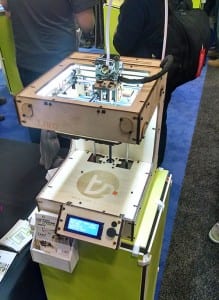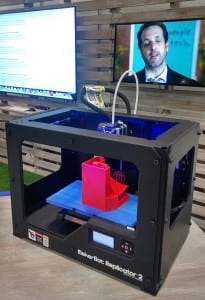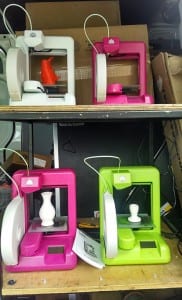You’ve heard about 3D printing, right? It seems cool in concept, and I’m sure it’ll revolutionize many aspects of manufacturing and related businesses, but I didn’t really pay attention to what seemed to be a “novelty” so far. On top of that, I didn’t come to SXSW expecting that I’d learn a lot about what seemed to be a manufacturing (“Non-Tech”) thing.
Well, 3D printing isn’t just for big companies to prototype their new products, or for engineers to craft models before building the real thing. Here at SXSW, several makers of 3D printers are showing off models that are clearly aimed at the small company, serious hobbyist and even arts-and-crafts enthusiasts.
First, I saw the Tinkerine.
 Aimed at the DIY-Engineer crowd, it looks like one of those kit things my dad ordered when I was a kid. It has plywood forms and nuts-and-bolts construction updated for this century, but you build it yourself.
Aimed at the DIY-Engineer crowd, it looks like one of those kit things my dad ordered when I was a kid. It has plywood forms and nuts-and-bolts construction updated for this century, but you build it yourself.
The Tinkerine was on display at the Game Expo, so I assume they were going for more of the geek-chic approach. They also emphasize their “open source” approach to the schematics that you feed into the machine to print things – a concept that goes over well here at SXSW.
The next day, I saw the Makerbot.
 This one looks serious, like it could turn out mini-Terminators. I assume it’s aimed at the corporate market, with its more serious, industrial-looking construction.
This one looks serious, like it could turn out mini-Terminators. I assume it’s aimed at the corporate market, with its more serious, industrial-looking construction.
Makerbot has done several generations of these machines already, so they seem to be the big dog in desktop 3D printing.
Ok, but don’t these things cost thousands of dollars to purchase? Some do, but clearly the market is heading toward mainstream use.
Then I came across the 3D Systems van outside the trade show. These folks are demoing their nifty little 3D printers to anyone walking by on the street.
 Included in their demo is the ChefJet, which prints with sugar (can it make Swedish Fish?!?) and as a smaller unit, are clearly the “Personal 3D Printer” for at-home arts-and-craft folks.
Included in their demo is the ChefJet, which prints with sugar (can it make Swedish Fish?!?) and as a smaller unit, are clearly the “Personal 3D Printer” for at-home arts-and-craft folks.
I expect the 3D Systems printers will go for well under $1,000. To me, it looks something akin to the EasyBake Oven – more than just a toy, but fun to work with and good for actually making useful things at home.
There are a lot of other considerations to 3D printing, including the software used to drive them and the “plans” used to craft a specific item, but the market also seems well on the way to working those things out.
I hadn’t seriously considered getting a 3D printer at home, but soon I’m sure we’ll all have one, and there will be 3D printers available everywhere, just like vending machines.
Note to self: convince my wife that we need a Tinkerine!


